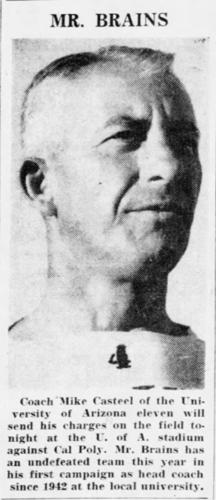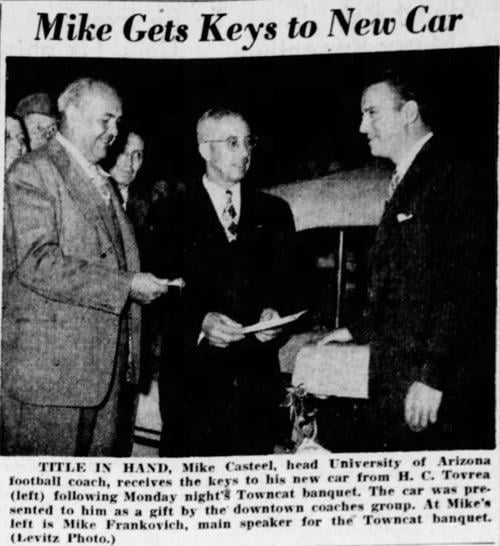If there is a football heaven, Mike Casteel was surely confused when he arrived at the Pearly Gates in the spring of 1977.
“Bear Down, Coach,” Button Salmon might’ve said. “But … is that a Sun Devil logo on your pocket?”
Across 119 years of Territorial Cup football, there has been no man, woman or child more divided — Wildcats or Sun Devils? — than Miles Webster “Mike” Casteel of Elmira, New York.
The man who was awarded a Silver Star for bravery in World War I would encounter enemies of a different kind when he coached football at Arizona from 1939-48 and then flipped, becoming executive director of ASU’s booster club from 1950-73.
Casteel’s aggressive vision for small-time Arizona football was such that he added mighty Notre Dame to the 1941 schedule. By the time he was fired, Arizona Stadium had been expanded from 10,000 to 22,600 seats.
Arizona State? The Sun Devils, then called the Bulldogs, were so insignificant that Casteel did not schedule a Territorial Cup game his first two seasons. When the teams played in 1946, Arizona won 67-0. Casteel never lost to ASU.
Casteel was a Wildcat and Tucsonan of such prominence that during World War II he was part of the committee that brought the PGA Tour to Tucson for the first time, created the high school football All-Star Game, North v. South, played in Tucson, and was host of a radio program “Punt Formation.”
When the UA paused its football program in 1943 and 1944, Casteel was kept on the school’s payroll to operate a special recreation program for World War II soldiers stationed at Davis-Monthan Air Force Base and Army specialists who took occupation of Bear Down Gym.
The Towncats, Arizona’s equivalent of today’s Wildcat Club, bought Casteel a new car in 1947 to celebrate the UA’s appearance in the Salad Bowl, a New Year’s Day bowl game played in Tempe.
Three weeks later the most popular Wildcat in town was fired.
Friction between Casteel and UA athletic director Pop McKale, as well the man behind the money of the powerful copper industry, Cleon Knapp of Phelps Dodge, swung a divided vote of the Board of Regents to fire Casteel.
“It was a terrible thing they did to Mike,” prominent Tucson attorney Tom Chandler said in the 1970s book “They Fought Like Wildcats.”
“They had all kinds of stories going. They gossiped about a single man having a girl friend. And Knapp wanted an assistant coach from USC. At the time, the copper companies were running the state.”
Devastated, Casteel told the Star: “It kind of breaks up a guy.”
Thus ended Arizona’s 50-year reign in the Territorial Cup.
A year later, ASU hired Casteel to be executive director of the lowbrow Sun Angel Foundation. Casteel engineered a massive period of growth in which membership of the booster group grew from 300 to more than 13,000.
“I think of Mike in many ways as the savior of the Foundation and our football program,” iconic ASU football coach Frank Kush said upon Casteel’s death in 1977. “You have to credit him for keeping the booster club together and insisting on high ethical standards during a time many schools went outside of the rules.”
Today it would be unthinkable for a Beaver to become a Duck at the highest level of college football, or a Trojan a Bruin. But for more than three decades, Casteel had his fingerprints all over the success of both Arizona and ASU.
The clearest picture of the climate Casteel encountered in both Tucson and Tempe came from Ed Doherty, the man hired to dig ASU out of the mess from that 67-0 loss to Casteel’s Wildcats.
“They told me when I took the ASU job (in 1947) that if I couldn’t beat Arizona within three years, the series would be canceled,” Doherty told the Star in 1982. “They made that very clear.”
Doherty beat the deadline, whipping Arizona in 1949. By that time Casteel had changed sides; the Territorial Cup would never be the same. The Sun Devils have since gone 39-29-2.
A lot of people give Kush the credit; it’s impossible to diminish his domination of the Territorial Cup from 1958-79. But before Kush started his Hall of Fame head coaching career, ASU was 6-3 with Casteel raising the money for a new stadium, scholarships and athletic department growth.
In the previous 50 years, ASU had gone an unfathomable 2-20 in the Territorial Cup.
“Before we hired Mike, we were stumbling along like a bunch of amateurs,” Jim Coles, a former executive in the Sun Angel Foundation, told The Arizona Republic after Casteel’s death. “He was just the sort of man we needed.”
When Casteel’s obituary was released by A.L. Moore and Sons mortuary of Phoenix, it said the man who built the football programs at both Arizona and ASU “had no survivors.”
Now, 41 years later, we know better. Mike Casteel was survived by legions of Wildcat and Sun Devil fans. His teams went 22-7 in the Territorial Cup.
If that’s not football heaven, what is?







